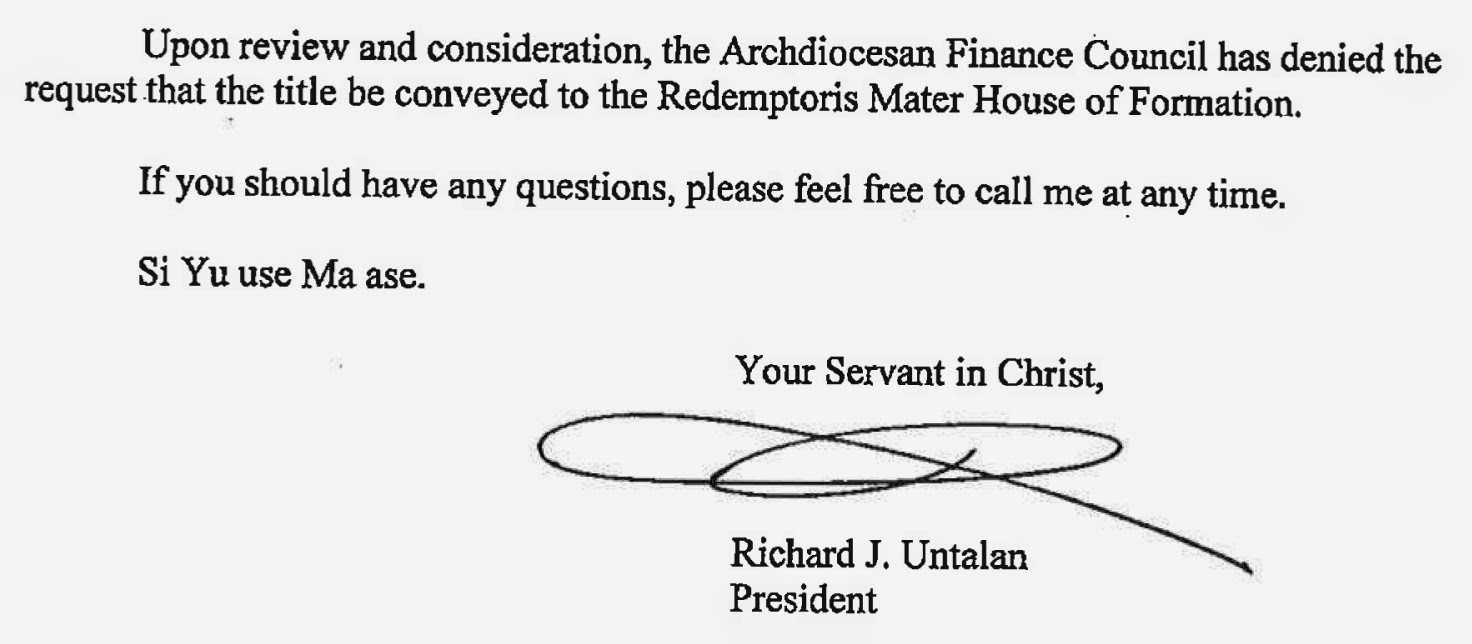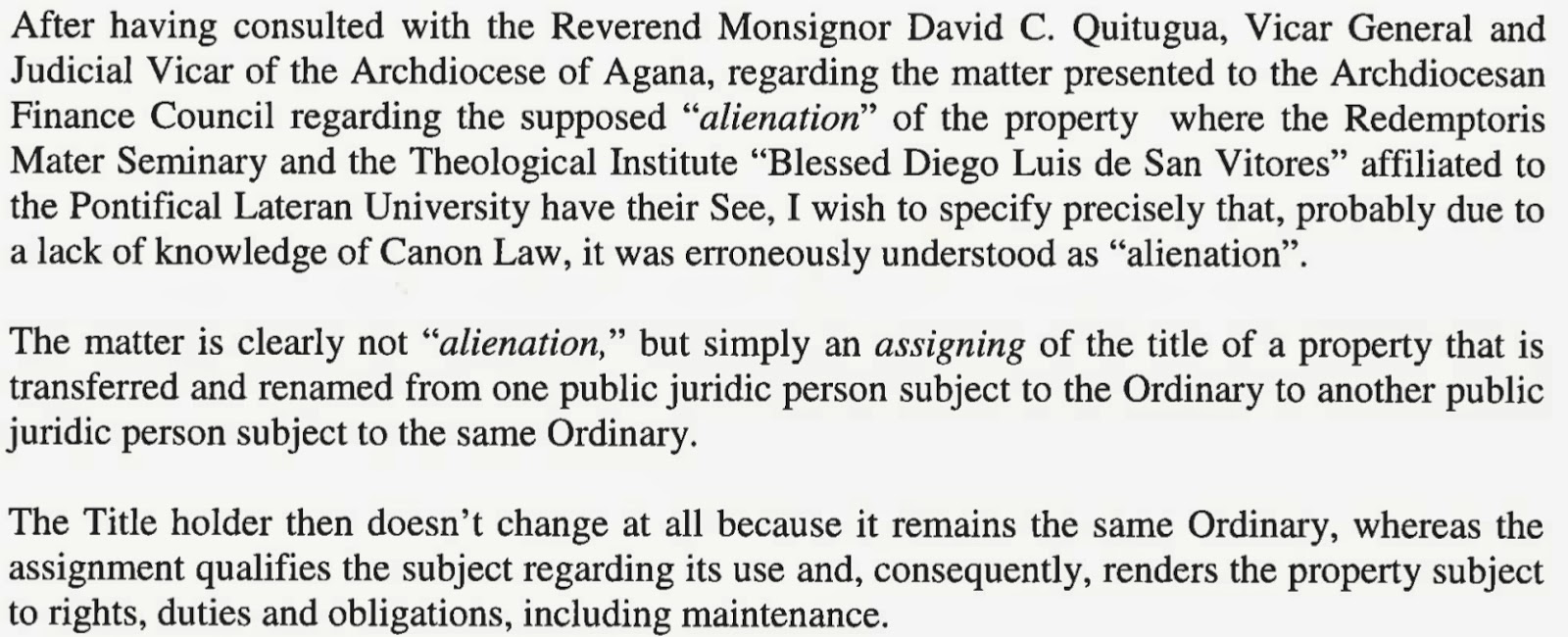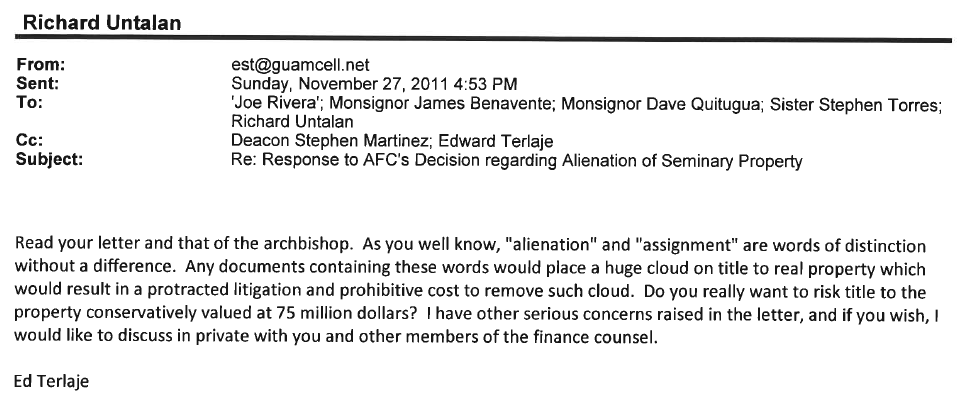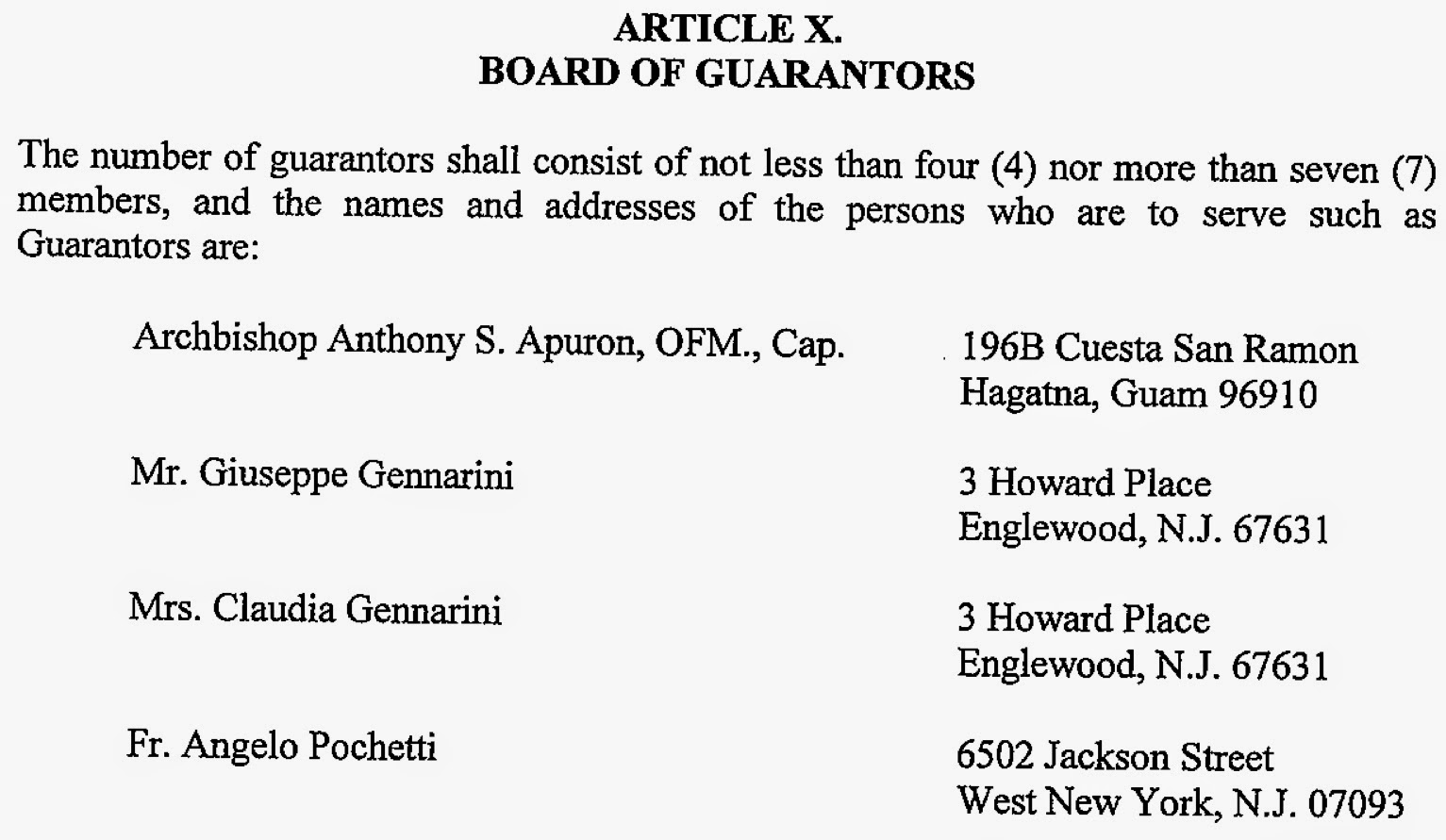Setting the Record Straight. Really Straight.
Jungle Watch
So the outright conveyance of the title to RMS was denied, but two months later, probably after a conference with the Gennarini's, Archbishop Apuron would write Richard Untalan:
There are several things to pay attention to in this letter. One would be the date the letter was actually delivered to Mr. Untalan's office: While the letter was written on November 16, 2011. It was not delivered to Mr. Untalan's office until November 25, 2011, THREE DAYS AFTER the Deed Restriction had already been recorded. So apparently Archbishop Apuron penned the letter, held it until the deed was recorded on 11/22, had the letter delivered to Untalan's office (after the fact), and then immediately departed Guam for Boston because we find him there on November 27, 2011: [thebostonpilot.com] There is something else that is important in this letter. Archbishop Apuron states that the "title holder does not change" since this is supposedly only an "assignment" and not an alienation. Obviously, if Archbishop Apuron believe that to be true, then he simply could have advised Mr. Untalan that he intended to proceed with the assignment. Instead, he said nothing and recorded the deed without the knowledge of the legal counsel or the finance council. If there was nothing wrong with doing this then there would have been no reason not to advise the AFC that he was proceeding. He did not. The chancery continues: The establishment of a diocesan seminary and a prestigious Theological Institute are “goods” of such paramount importance for the life of the diocese that to think to sell the property to cover a deficit is unthinkable and it would be irresponsible for the Archbishop to even harbor that idea. The Seminary and the Institute are both essential for the future of the Archdiocese of Agana. The seminary and the Institute are also fundamental to help the evangelization in the Pacific. In fact, four dioceses have already sent twelve seminarians to the Seminary and Institute and many other dioceses are planning to do so. Given the importance of the Seminary and of the Theological Institute in the life of a diocese, canon law requires that a seminary may possess those means necessary for fulfilling its goals (see Code of Canon Law ca. 114). Among its fundamental means there is the stability of the property on which it is operating. OUR COMMENT The chancery speaks as if there will be no more Archdiocese of Agana if we didn't have this particular property. Notwithstanding that the sale of the property could have financed the building of a much more efficient seminary building and financed the education of seminarians to boot, how has the Archdiocese of Agana managed all these years before RMS, and even 20 to 30 years ago when we had many more local vocations than we have now? Of course we managed, even thrived without a local seminary. Many dioceses, especially small ones do not have their own seminaries and for good reason. Given the small population of such dioceses it is cost prohibitive to sustain a seminary of such quality that men desirous of the priesthood should have access to. And as for evangelization in the Pacific depending on RMS? What about the Regional Seminary for the Episcopal Conference of the Pacific in Fiji, which has been producing priests for this region since the 1970's and not only has an established curriculum and faculty, but was promoted by St. John Paul II in 1986 as the seminary all the region's bishops were to support. Of course when this chancery says "new evangelization" they don't mean the "new evangelization" as St. John Paul II meant it. They mean the Neocatechumenal Way. And the Regional Seminary is not neo. Let's move on the Question #2 2. Can you confirm that the Redemptoris Mater Seminary is for the Neocatechumenal Way and not a Diocesan Seminary? ANSWER This is absolutely false and wrong. The building hosts the Redemptoris Mater Seminary, from which have been ordained 16 diocesan priests for Guam. Twelve of these diocesan priests are working in this archdiocese ministering in the parish, and not for the neocatechmenal (sic) way. OUR COMMENT It really doesn't matter where they are working. What matters is what they were trained to do. And they were trained specifically to serve the Neocatechumenal Way. It says so in Art. III of the RMS Articles of Incorporation:
The reason they are being placed in parishes of course is to eventually break those parishes into the "small communities" which the NCW believes is the successor model to parish-based Catholicism. Even if this wasn't true, the fact remains that these men are being prepared to "follow the life and itinerary of the Neocatechumenal Way", NOT the traditional diocesan priesthood. The chancery continues: Moreover the building hosts also the Blessed Diego Luis de San Vitores Theological Institute which provides the theological formation for the Redemptoris Mater Archdiocesan Seminary and the St. John Paul the Great Diocesan Seminary. Without the building we would not have the possibility of forming priests for our archdiocese and also to help other dioceses in need in the pacific (sic). OUR COMMENT Again, with "the building". Not only could a far superior facility have been built without taxing Guam's Catholics hundreds of thousands of dollars like the current RMS is doing now, an existing building, like the old Carmelite monastery in Malojloj would have sufficed. If it is good enough for the men studying for the traditional diocesan priesthood, then it would have been good enough for those in the Neocatechumenal Way. The chancery goes on about the Blessed Diego Institute's affiliation with the Lateran University but the Institute has never produced any documentation that the affiliation exists, or, if it did, if it is current. Question 3: 3. Is it true that because the property has been designated to RMS it can no longer be included in the Asset of the Archdiocese of Agana? (It should say "as an asset" of...) Answer No, this is totally false. The property is designated for the use of the seminary respecting the intention of the donors, but the Archbishop can designate it for other use in the future, respecting however the intention of the donors who gave money to acquire a building for the Redemptoris Mater Archdiocesan Seminary and for the Theological Institute, the title is listed in the property of the Archdiocese of Agana, as it is easily verifiable and it has never been alienated. This property came into the archdiocese thanks to the Neocatechumenal Way, not the other way around. OUR COMMENT Archdiocesan legal counsel, Edward Terlaje, former AFC president, Richard Untalan, or even the title company which worked on the acquisition can attest to the fact that the donor DID NOT give "money to acquire a building for the Redemptoris Mater Archdiocesan Seminary." (Notice that the chancery leaves out the word "Missionary" in the name of the seminary here). The property had already been acquired through a loan with the Bank of Guam, a loan which Mr. Untalan and Mr. Terlaje worked very hard to acquire. The donation was likewise acquired by the hard work of many people, specifically Mother Dawn of our local Carmelite order, who petitioned a sister Carmelite community in St. Louis, Missouri, and through them located a donor. Neither the local Carmelites nor the community in St. Louis are in anyway affiliated with the NCW and neither was the donor. The NCW had absolutely NOTHING to do with acquiring the property and everything to do with the efforts of Mr. Terlaje, Mr. Untalan, and Mother Dawn. Also let's look closer at the chancery's claim in the above answer: "...the title is listed in the property of the Archdiocese of Agana, as it is easily verifiable and it has never been alienated." Here we must look at Atty. Ed Terlaje's opinion which he gave to the AFC on the matter:
Note the statement: "As you well know, 'alienation' and 'assignment' are words of distinction without a difference", and "Any documents containing these words would place a huge cloud on title..." Now lets look at Archbishop Apuron's DECREE OF DESIGNATION:
Notice the word ASSIGN and refer back to Atty. Terlaje's warning: "Any documents containing these words (assignment) would place a huge cloud on title." Why does Atty. Terlaje say this if Archbishop Apuron is so sure that the "title holder does not change?" Because Atty. Terlaje was the attorney who drafted the original RMS corporate documents and had argued against the inclusion of a Board of Guarantors and specifically against the power that Mr. Gennarini insisted that the Board be given. In other words, Atty. Terlalje knew exactly what the problems would be when he drafted the documents for Archbishop Apuron in 2002 and knew exactly why there was now a problem in 2011. The chancery continues with an insert of an official sounding Vatican letter: The Pontifical Council for the Interpretation of Legislative Acts, the highest Vatican Body for the Interpretation of legislative acts (church law), wrote concerning this particular issue that: I. This was not at an act of alienation but of designation and that the property was as well secure in the hands of the Archdiocese: “it was just a transfer of title between two corporations sole which have the same and only member who enjoys alone of all powers of extraordinary administration.” II. Since the intention of the donation was for the erection of the Seminary and of the Theological Institute, the designation of the title to the “corporation sole” Redemptoris Mater was therefore an act which was obligatory to respect the intention of the donation. OUR COMMENT The chancery probably thinks this letter from the Vatican is a "grand slam" shutting up all opposition. But a letter from the Vatican means absolutely nothing in Guam when the issue is real property. Real property on Guam is subject to the laws of Guam, not the laws or the opinions of the Vatican. Plus we can easily see that the Vatican was fed incomplete information because it parrots the chancery's claim that the intention of the donation was for the erection of RMS. Mother Dawn, Richard Untalan, and Atty. Terlaje can tell you that there is no such mention of RMS in the letter from the donor which accompanied the donation. Thus, it is obvious that this particular pontifical council simply was processing the information that it was sent. And the only information which was sent to it was what the chancery and RMS wanted it to have. Going on. 4. Who is part of the Corporation for the Redemptoris Mater Seminary? I understand that Archbishop Apuron holds 25% so who holds the remaining 75%? ANSWER. I do not know who invents these things: the Redemptoris Mater Seminary is a corporation sole which means that it is governed exclusively by only one member, the Archbishop of Agana (the ordinary). As in every corporation sole all decisions pertains to the archbishop. The Archbishop has two Boards to assist in matters pertaining to the seminary: the Board of Directors reviews annually the daily management of the seminary; the Board of Guarantors does not manage at all the seminary neither ordinarily nor extraordinarily but only guarantees that the purposes of the corporation are “in accordance with the Articles of Incorporation and the Laws of Guam”. Directors and Guarantors are appointed exclusively by the sole member, that is the Archbishop, and he can change them whenever there is need. OUR COMMENT We have gone over this before, but let's do it again since the chancery persists with its campaign of misinformation. The chancery is not being forthcoming when it states that the Board of Guarantors "does not manage at all the seminary neither ordinarily nor extraordinarily but only guarantees that the purposes of the corporation..." Here is what Article IX actually says:
Notice that the chancery stops short of telling us that the Board of Guarantors has a veto or approval power for the most important affairs of the Corporation. Why do they leave that out? Because it nullifies their previous claim that the Board of Guarantors "does not manage at all the seminary ordinarily nor extraordinarily." (By the way, this is such clumsy wording it is very likely not Atty. Terlaje's wording. And knowing that he was opposed to the insertion of this article, it is very likely NOT his.) In fact, of course, having veto or approval power for the most important affairs of the Corporation gives the guarantors absolute control over everything since they can decide just what the "most important affairs" are. Going on, the chancery states that the "Guarantors are appointed exclusively by the sole member, that is the Archbishop, and he can change them whenever there is need." Well, NO he can't. He can't because Article VII.2. of the RMS By Laws restricts him from doing so:
As we can see, "the Neocatechumenal responsible Team for the United States is part of this board." That means that Archbishop Apuron is restricted as to who he can appoint. He cannot determine who that "responsible Team" is thus he CANNOT "change them whenever there is a need." There are certain people who must always be on that board and Archbishop Apuron has no say who they are. Sadly, this is serious misinformation. Lastly, lets back up to where the chancery states: "the Redemptoris Mater Seminary is a corporation sole which means that it is governed exclusively by only one member, the Archbishop of Agana (the ordinary). " Article IX of the Articles of Incorporation gives the Board of Guarantors complete veto and approval power over every aspect of the management of RMS because that same board can decide what the most important affairs are.
By the way, it is curious that Archbishop Apuron uses his own name instead of "Archbishop of Agana" which then would include his successors. Instead, he only uses his name, which keeps him on the board even if he is removed as Archbishop of Agana. So yes, Tony Diaz, as per your editorial in this same edition of the U Matuna, while we would like to work for peace, we must contend with religious leaders who either outright mislead us or who are completely controlled by an authority other than the one the rest of us want to follow. May I recommend you begin questioning just why you want to keep defending the same people who gave us this?
|
.
Any original material on these pages is copyright © BishopAccountability.org 2004. Reproduce freely with attribution.







